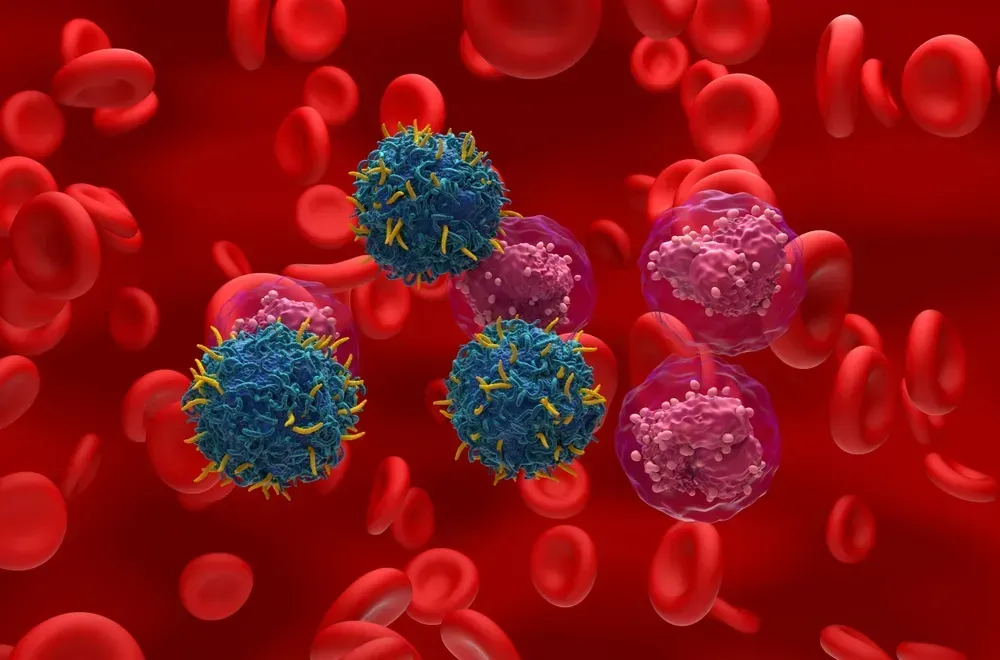How Do You Know When CAR-T is Right for You?

When navigating treatment options for relapsed or refractory multiple myeloma (RRMM), CAR T-cell therapy has become a game-changer.
With recent advancements in approvals, breaking information from clinical trials, and ongoing debates among doctors, understanding where and when CAR-T fits into your treatment plan is critical. Here’s what you need to know.
Proven Survival Benefits in Early Relapse
Two groundbreaking Phase 3 trials have expanded the use of CAR T-cell therapies, offering new hope for patients with relapsed or refractory multiple myeloma:
-
CARVYKTI (cilta-cel): Approved for use after one prior line of therapy, CARVYKTI’s effectiveness was demonstrated in the CARTITUDE-4 trial. This study showed that cilta-cel reduced the risk of disease progression or death by 59% compared to standard treatments. Patients experienced deeper and longer-lasting responses, making it a compelling option for early relapse.
-
ABECMA (ide-cel): Approved for use after two or more prior lines of therapy, ABECMA’s success was highlighted in the KarMMa-3 trial. This trial revealed that ide-cel tripled the time patients were in remission compared to standard therapies and reduced the risk of disease progression or death by 51%.
At the International Myeloma Society (IMS) meeting, Dr. Maria Mateos shared the findings that long-term CARVYKTI results are proving to have better overall survival (OS) and progression-free survival (PFS) when used against standard-of-care therapies between lines 2-4 of therapy. In the same conference, ABECMA was also shown to have better OS and PFS when compared to the standard of care in its current indication.
The Debate: When is CAR-T Most Optimal?
With the recent approvals expanding the use of ABECMA and CARVYKTI for myeloma patients at earlier stages of treatment, the question then becomes: when is the optimal time to receive CAR-T?
Doctors are still deliberating the ideal time to introduce CAR-T into the treatment sequence.
At the IMS conference earlier this year, Drs. Rahul Banerjee and Sridevi Rajeeve modeled the two schools of thought surrounding the decision, shown in the mock debate video and notes below.
Dr. Sridevi Rajeeve: Use CAR-T Early
- Attrition rates: As patients progress through multiple lines of therapy, fewer remain eligible for intensive treatments like CAR-T due to disease progression, declining health, or the passing of patients.
- Biology of the disease: Myeloma often becomes more resistant over time, reducing the effectiveness of therapies. Early CAR-T can maximize the chances of long-term disease control.
- Clinical evidence: CAR-T has shown superior survival outcomes and response rates compared to the standard therapies used in second-line treatment.
Dr. Banerjee: Reserve CAR-T for Later
-
Logistical challenges: CAR-T requires a complex process, from T-cell collection to manufacturing and infusion. Patients often need to relocate to academic centers for up to 4-5 months, which can be disruptive.
-
Improving technology: Waiting for future CAR-T advancements could result in even better outcomes, especially for patients with standard-risk myeloma.
-
Alternative options: Many standard-of-care (SOC) therapies like Daratumumab/Pomalidomide/Dexamethasone provide excellent results and are more accessible than a CAR-T administration.
For patients, the decision boils down to balancing access, convenience, and the biological behavior of their disease. That’s why your potential eligibility for CAR-T and its pros and cons need to be carefully discussed with your care team.
Projected Outcomes: CAR-T vs. Standard Therapy
Dr. Rafael Fonseca, a leader in the world of myeloma research, shared results from a model he and his team created to predict outcomes with CAR-T in earlier lines of therapy.
Using real-world data comparing patients on the CARTITUDE-4 trial and comparing results from patient data found in the Flatiron database, the model projected outcomes based on when CAR-T is administered:
-
Second line (early use of CAR-T): Patients initiating CAR-T at first relapse followed by standard therapy at the next relapse had an estimated overall survival (OS) of 8.8 years.
-
Third line (delayed use of CAR-T): Patients starting with standard therapies before moving to CAR-T in the third line had a shorter OS of 5.5 years.
This 3.3-year difference highlights the potential benefits of earlier use, particularly for patients with aggressive disease or limited time to access CAR-T. Though this is information based on a model, not a clinical trial, it’s very important insight to have for patients and physicians while we wait years for seasoned clinical data to give us more accurate information.
Interestingly, while Dr. Fonseca himself was involved in this study, he has not made a clear-cut decision to treat all his patients with CAR-T at the second line of therapy, rather, he is more open to treating patients who would benefit the most.
Talk to Your Doctor About CAR-T
While CAR-T offers hope, it’s not for everyone. Here’s how to navigate your options:
- Understand your disease biology: Discuss whether your myeloma is high-risk or standard-risk and how this impacts treatment decisions.
- Consider your location and lifestyle: Proximity to a CAR-T center and the time required for treatment may influence your choice.
- Factor in your life stage: Your age and overall health can play a role in deciding the timing of intensive therapies.
- Consult a specialist: Engage with an academic center or a doctor specializing in CAR-T therapy for a comprehensive evaluation.
Be Prepared, Stay Informed
CAR T-cell therapy represents a significant advancement in myeloma care, but its use requires careful planning and consultation. By staying informed and having proactive discussions with your care team, you can make the best decision tailored to your unique needs.
Remember: Just because CAR-T is an option doesn’t mean it’s the right option for everyone—timing, readiness, and the myeloma’s biology matter.
Continue your learning about CAR T-cell therapy with HealthTree University. Create a free account to save your favorite videos and mark your progress in the link below:
When navigating treatment options for relapsed or refractory multiple myeloma (RRMM), CAR T-cell therapy has become a game-changer.
With recent advancements in approvals, breaking information from clinical trials, and ongoing debates among doctors, understanding where and when CAR-T fits into your treatment plan is critical. Here’s what you need to know.
Proven Survival Benefits in Early Relapse
Two groundbreaking Phase 3 trials have expanded the use of CAR T-cell therapies, offering new hope for patients with relapsed or refractory multiple myeloma:
-
CARVYKTI (cilta-cel): Approved for use after one prior line of therapy, CARVYKTI’s effectiveness was demonstrated in the CARTITUDE-4 trial. This study showed that cilta-cel reduced the risk of disease progression or death by 59% compared to standard treatments. Patients experienced deeper and longer-lasting responses, making it a compelling option for early relapse.
-
ABECMA (ide-cel): Approved for use after two or more prior lines of therapy, ABECMA’s success was highlighted in the KarMMa-3 trial. This trial revealed that ide-cel tripled the time patients were in remission compared to standard therapies and reduced the risk of disease progression or death by 51%.
At the International Myeloma Society (IMS) meeting, Dr. Maria Mateos shared the findings that long-term CARVYKTI results are proving to have better overall survival (OS) and progression-free survival (PFS) when used against standard-of-care therapies between lines 2-4 of therapy. In the same conference, ABECMA was also shown to have better OS and PFS when compared to the standard of care in its current indication.
The Debate: When is CAR-T Most Optimal?
With the recent approvals expanding the use of ABECMA and CARVYKTI for myeloma patients at earlier stages of treatment, the question then becomes: when is the optimal time to receive CAR-T?
Doctors are still deliberating the ideal time to introduce CAR-T into the treatment sequence.
At the IMS conference earlier this year, Drs. Rahul Banerjee and Sridevi Rajeeve modeled the two schools of thought surrounding the decision, shown in the mock debate video and notes below.
Dr. Sridevi Rajeeve: Use CAR-T Early
- Attrition rates: As patients progress through multiple lines of therapy, fewer remain eligible for intensive treatments like CAR-T due to disease progression, declining health, or the passing of patients.
- Biology of the disease: Myeloma often becomes more resistant over time, reducing the effectiveness of therapies. Early CAR-T can maximize the chances of long-term disease control.
- Clinical evidence: CAR-T has shown superior survival outcomes and response rates compared to the standard therapies used in second-line treatment.
Dr. Banerjee: Reserve CAR-T for Later
-
Logistical challenges: CAR-T requires a complex process, from T-cell collection to manufacturing and infusion. Patients often need to relocate to academic centers for up to 4-5 months, which can be disruptive.
-
Improving technology: Waiting for future CAR-T advancements could result in even better outcomes, especially for patients with standard-risk myeloma.
-
Alternative options: Many standard-of-care (SOC) therapies like Daratumumab/Pomalidomide/Dexamethasone provide excellent results and are more accessible than a CAR-T administration.
For patients, the decision boils down to balancing access, convenience, and the biological behavior of their disease. That’s why your potential eligibility for CAR-T and its pros and cons need to be carefully discussed with your care team.
Projected Outcomes: CAR-T vs. Standard Therapy
Dr. Rafael Fonseca, a leader in the world of myeloma research, shared results from a model he and his team created to predict outcomes with CAR-T in earlier lines of therapy.
Using real-world data comparing patients on the CARTITUDE-4 trial and comparing results from patient data found in the Flatiron database, the model projected outcomes based on when CAR-T is administered:
-
Second line (early use of CAR-T): Patients initiating CAR-T at first relapse followed by standard therapy at the next relapse had an estimated overall survival (OS) of 8.8 years.
-
Third line (delayed use of CAR-T): Patients starting with standard therapies before moving to CAR-T in the third line had a shorter OS of 5.5 years.
This 3.3-year difference highlights the potential benefits of earlier use, particularly for patients with aggressive disease or limited time to access CAR-T. Though this is information based on a model, not a clinical trial, it’s very important insight to have for patients and physicians while we wait years for seasoned clinical data to give us more accurate information.
Interestingly, while Dr. Fonseca himself was involved in this study, he has not made a clear-cut decision to treat all his patients with CAR-T at the second line of therapy, rather, he is more open to treating patients who would benefit the most.
Talk to Your Doctor About CAR-T
While CAR-T offers hope, it’s not for everyone. Here’s how to navigate your options:
- Understand your disease biology: Discuss whether your myeloma is high-risk or standard-risk and how this impacts treatment decisions.
- Consider your location and lifestyle: Proximity to a CAR-T center and the time required for treatment may influence your choice.
- Factor in your life stage: Your age and overall health can play a role in deciding the timing of intensive therapies.
- Consult a specialist: Engage with an academic center or a doctor specializing in CAR-T therapy for a comprehensive evaluation.
Be Prepared, Stay Informed
CAR T-cell therapy represents a significant advancement in myeloma care, but its use requires careful planning and consultation. By staying informed and having proactive discussions with your care team, you can make the best decision tailored to your unique needs.
Remember: Just because CAR-T is an option doesn’t mean it’s the right option for everyone—timing, readiness, and the myeloma’s biology matter.
Continue your learning about CAR T-cell therapy with HealthTree University. Create a free account to save your favorite videos and mark your progress in the link below:

about the author
Audrey Burton-Bethke
Audrey is a content writer and editor for the HealthTree Foundation. She originally joined the HealthTree Foundation in 2020. Audrey loves spending time with her supportive husband, energetic four-year-old, and new baby.
More on Conferences
Trending Articles
Upcoming Events




Get the Latest Multiple Myeloma Updates, Delivered to You.
By subscribing to the HealthTree newsletter, you'll receive the latest research, treatment updates, and expert insights to help you navigate your health.
Together we care.
Together we cure.
3x Faster.













